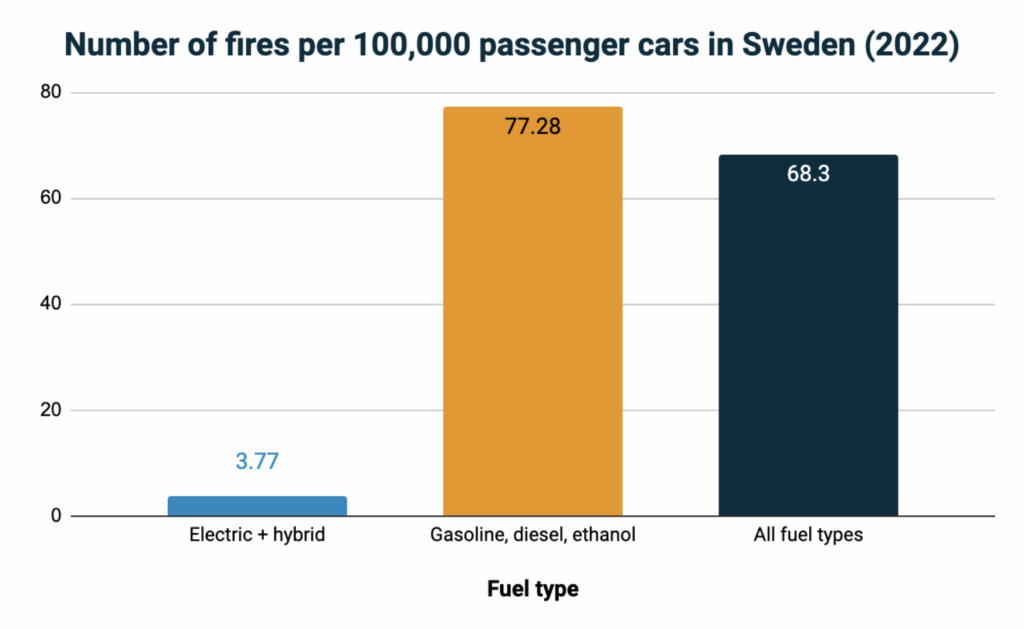Whether you drive an EV or not, you have likely encountered sensationalized stories and claims about EV battery fires. EV fire incidents have been used to justify charging station siting restrictions in Illinois, battery sourcing requirements in South Korea, shipping restrictions in Alaska, and other policies around the world. But is this new vehicle technology more dangerous than the fast-moving tanks of flammable fuel we already have—gas vehicles?
The simple answer is that EV and gas vehicle fires are fundamentally different, but EV fires are very rare. If you’re comfortable accepting the fire risk of gas cars, you don’t need to lose sleep about EV fires. Since EVs are a relatively new technology on a larger scale, they also continue to become safer. Vehicle and battery manufacturers, fire departments, and charging providers are all working to make EVs even safer, so there is very little that EV drivers need to worry about. However, knowing the facts about EV fires can be helpful for educating others, making an informed purchase or lease decision, and understanding the risks of driving any vehicle.
Studies show EVs are much less likely to catch fire than gas vehicles.
One of the most comprehensive and long-term studies of EV fire likelihood comes from the Swedish Civil Contingencies Agency. Sweden is one of the world’s top EV adopters, with battery electric and plug-in hybrid vehicles making up over 58% of new registrations in 2024.
Sweden has collected EV and hybrid vehicle fire statistics from 2018 to 2024.
In an archived report from 2022, the agency also reported the total number of vehicles that catch fire each year, regardless of fuel type. The chart below shows calculations for the number of fires per 100,000 vehicles in 2022 for EVs and hybrids, combustion vehicles (mainly gas cars), and all passenger cars. According to this data, combustion vehicles are more than 20 times more likely to catch fire than electric and hybrid cars.

Source: MSB of Sweden, 2023
Tesla uses a different metric when reporting the fire likelihood of their vehicles. Tesla stated in a report that between 2012 and 2023, approximately one Tesla electric vehicle fire event occurred for every 130 million miles traveled. During the same period, one vehicle fire of any fuel type occurred in the U.S. for every 17 million miles traveled, according to data from the National Fire Protection Association. Tesla reports that their vehicles catch fire about 7 times less frequently than the national average.
It is worth looking into the causes of vehicle fires in each study. Arson and fire spreading from another structure cause many vehicle fires, which have nothing to do with EV batteries. For example, a recent study from Poland found that 13% of battery electric vehicle fires in the first half of 2025 were caused by arson or a fire transfer. The Swedish study does not include arson fires in its EV fire compilation, but arson fires are included in the total number of vehicle fires of all fuel types. Tesla’s report includes vehicle fires started from an external fire, such as wildfires, arson, and structure fires. The National Fire Protection Association does not report fires that involve a structure. These differences in reporting may cause some inconsistencies in the total reported number of fires.
A significant number of fires have an unknown cause in most vehicle fire studies, since these studies often rely on anecdotal reports from first responders who might not know the cause of the fire. The most common known causes of EV fires include collision or road debris, a battery fault, and overheating, according to a global study by EV FireSafe. Gas vehicle fires have many of the same causes, including battery faults or electrical issues, which caused 656 fossil-powered passenger car fires in Sweden from 2018 to 2022.
Submersion in saltwater caused some of the EV fires in these studies, but these incidents are rare. Research from the Idaho National Laboratory found that less than one percent of EVs impacted by Hurricane Ian in 2022 caught fire, and advancements in battery pack designs may have helped many vehicles mitigate flood damage and fire risks. Drivers’ preventative measures, such as moving cars to higher ground and having them serviced immediately after a known flood event, can significantly reduce the risk of battery corrosion.
At the moment, there are not enough broad and long-term studies of vehicle fires to make a definitive statement about the likelihood and causes of EV fires, although all credible studies claim that EV fires are not more likely than gas vehicle fires. The U.S. Fire Administration (USFA, part of FEMA) will be switching to a new voluntary fire incident reporting system called NERIS in 2026, which will provide more information about EV fire incidents than the old system. Plug In America will update this page as better EV fire data becomes available.
EVs and gas cars burn differently, which gives EVs some advantages.
EV battery fires start through a process called thermal runaway. Each battery contains individual cells that form larger modules. When there is a disturbance to one cell, which could be caused by a collision, overheating, or overcharging, the cell short-circuits and generates more heat, which spreads to other cells, leading to a self-sustaining chemical reaction. The battery cells can then ignite one by one. In contrast, all of a gas vehicle’s fuel is concentrated in one tank, which means that all of this fuel can catch on fire immediately, as shown in a 2023 study.
This period between battery cell failure and vehicle ignition can give EV drivers and passengers at least 5 minutes to exit the vehicle before the battery pack fully ignites, according to a 2021 study. In vehicles compliant with current regulations, an alarm will go off once the first cell failure is detected. EV FireSafe, a research agency supported by the Australian government, studied 511 EV battery fires globally from 2010 to 2024 and found that “in all [fire] incidents where drivers & passengers were not injured in a collision, they were able to exit the vehicle before it became fully involved in fire.” Manufacturers are working to design batteries that can delay ignition even longer, which would give trapped or injured passengers even more time to exit the vehicle. Those extra five or more minutes can be life-saving for drivers and passengers.
EV charging is safe, and fire incidents while charging are rare.
While some EV fires have started while a vehicle was charging, these fires are largely preventable through responsible maintenance and engineering. In their study, EV FireSafe found that fire incidents while charging were mainly caused by EVs that were previously damaged from a collision, saltwater submersion, battery fault, or an external fire. Damage from these scenarios is a leading cause of EV fires overall. The report notes that “in normally operated road-registered EVs, it is electrically impossible for the battery to be overcharged so it catches fire while using an electrically compliant unit that has been installed to standard by a qualified person.”
This means that as long as both EVs and charging stations are made, installed, and operated correctly, fire incidents while charging are nearly impossible. Properly installed charging stations pose no threat to fire safety on their own. Drivers should get their cars inspected after a collision or submersion incident, monitor battery recalls, and only use trusted public charging stations and power adapters when needed to reduce their risk. An extension cord should never be used with an EV. Public charging is essential for EV adoption and visibility, and fire safety concerns do not need to disrupt this progress.
Engineering and innovation are continuing to advance EV fire safety and fire response.
Unlike many older gas cars on the road, EVs are equipped with advanced safety features, which only improve over time. Technologies, including fireproof and insulating layers, onboard fire extinguishing systems, electrical current control, and intelligent alarm systems, are being developed by manufacturers to prevent, detect, and extinguish battery fires. When battery manufacturers, vehicle manufacturers, charging providers, and fire departments work together to advance EV fire safety, fire incidents will be even rarer and EVs will continue to rank among the safest vehicles.
Fire departments play a key role by responding to and containing EV fires. When EVs were first introduced, fire departments would attempt to extinguish battery fires like gas vehicle fires by spraying water on top of the vehicle. Since battery EV fires start with the battery compartment underneath the vehicle, this method does not extinguish the source of the fire and takes a very long time and a lot of water to completely cool the car down. Firefighters are now using different fire suppression methods, such as a specialized fire hose nozzle or fire blankets, to fight EV fires at the source.
It is important for first responders to verify if the vehicle on fire is an EV and to use effective fire suppression methods to minimize damage and injury. Luckily, a wealth of resources is available to first and second responders (which include towing and salvage companies), many of which are listed here by the Alternative Fuels Data Center. Departments should consider multiple fire suppression methods recommended in their training and choose the ones that best fit their community’s needs.
Fire departments should also try to collect data about vehicle fires and report it to the U.S. Fire Administration. Doing so will significantly improve the data quality available in the U.S. There are also new technologies being developed, such as this specialized nozzle invented by a firefighter from Naperville, Illinois. EV fires require a different approach, but with the proper training and equipment, emergency responders can be prepared for any scenario with confidence.
EV fires are rare and less likely than gas vehicle fires
Gas vehicles are all around us, and they are still the main contributors to around 200,000 fires and 500 fire deaths in the US per year (NFPA). Instead of making EVs a scapegoat, manufacturers, fire departments, and other stakeholders can work to improve fire safety for all vehicles, including EVs. Innovative battery engineering, preventative measures, and fire extinguishing technologies will greatly reduce the already small number of EV fires. If you value safety in a vehicle, EVs are the way to go.

